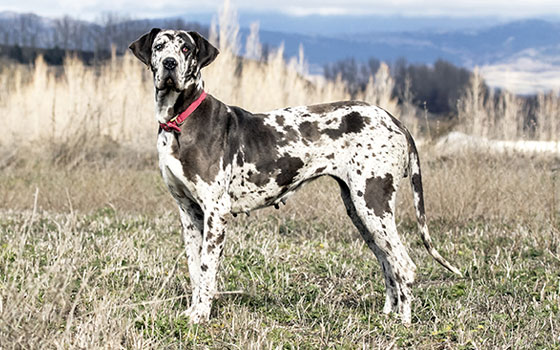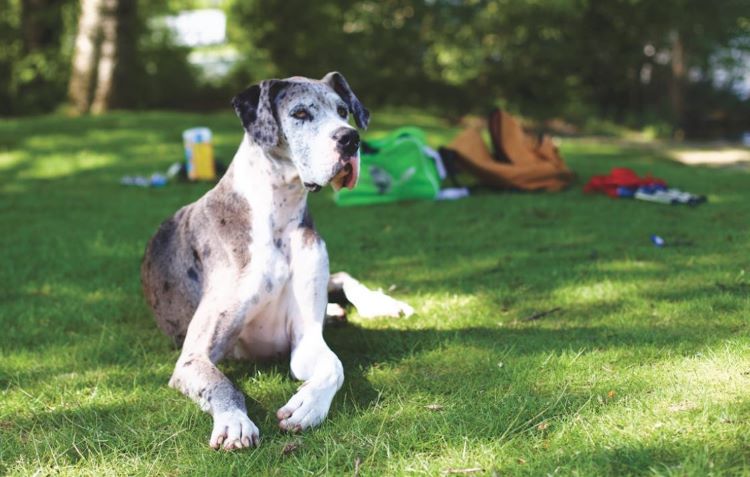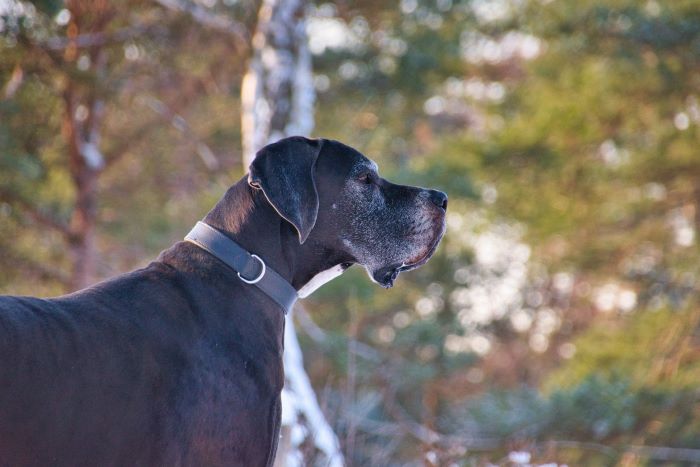Ready to help treat your pet to a healthy life?
Great Dane Guide: Breed History, Health & Fun Facts
By : Trupanion Staff | Updated Oct 3, 2024

The Great Dane, often called the "gentle giant" of the canine world, is a dog that turns heads with its massive size and calm, friendly vibe. That's right — don’t let this behemoth's stature fool you! Formerly bred as a hunting sidekick, today’s Great Dane is more about lounging on the couch and being a relaxed, loving buddy to its favorite humans. But is the Great Dane the right pet for you? Or, if you already have one, how well do you really know them?
In this guide, we’ll dig into everything you need to know about living with a Great Dane. From their standout looks and daily care needs to their laid-back temperament, health quirks, and how to train them, we've got you covered. Whether you're thinking of getting one of these big dogs or already have one, you'll find tips on grooming, feeding, exercise, and more. By the end, you'll have a solid grasp of what makes the Great Dane such a lovable, easygoing giant — and how to give them the best life possible. Let's kick things off with some fun facts!
10 unique facts about Great Danes
The Great Dane has a distinctive appearance and interesting history. That said, there are a lot of other things worth noting about the breed:
- They're one of the biggest dog breeds in the world. Though skinny, they're among the tallest canines!
- Did we mention these dogs are big? The average adult Great Dane weighs anywhere between 100 and 200 pounds (45 to 90 kg) and reaches between 28 and 32 inches tall (71 to 81 cm).
- Zeus, a Great Dane from Michigan, held the Guinness World Record for World’s Tallest Dog until he passed away in 2014. He measured 44 inches from toes to withers (where the shoulders are highest) and 7 feet 4 inches when he stood on his hind legs.
- This breed’s name is misleading — you might think they originated in Denmark, but they’re actually a German breed.
- Speaking of which, they're actualy the national dog breed of Germany!
- As big dogs who tend to burn a lot of energy when moving, these guys are big snoozers. Most Great Danes sleep between 12 and 14 hours a day, though some may go as high as 18.
- Scooby-Doo is a Great Dane. Supposedly, producers of the cartoon chose the breed partly because of the superstition from the Middle Ages that Great Danes helped to ward away ghosts. His imposing size also serves as delightful contrast to the character's fearful nature.
- William Penn, the founder of the state of Pennsylvania, owned a Dane. As such, the Great Dane is Pennsylvania’s official state dog.
- Chinese writings from 1121 B.C. and ancient Egyptian drawings depict dogs that closely resemble the Great Dane in size and color.
- Great Danes have earned a couple of popular nicknames: “Gentle Giant” and “Apollo of Dogs."
Breed description
Great Danes are easily recognizable thanks to their distinctive appearance. Tall and lanky, these pups have wide heads and expressive eyes. Their coat colors can vary widely, though most kennel clubs (including the American Kennel Club) recognize seven official hues and/or patterns:
- Black
- Blue
- Brindle
- Fawn
- Harlequin (more on this below)
- Mantle
- Merle
Though on the rarer side, some Danes have harlequin coloring. This comes from the same gene mutation as the merle coloring in other breeds. Though often viewed as just multicoloring, harlequin is a white coat with evenly spread black patches over the body.

Temperament
Great Danes are truly the gentle giant of the dog world. Don’t let their regal stature fool you — they love to entertain with kooky antics and goofy play. Their size doesn’t stop them from wanting to snuggle up with their people. Affectionate and easy-going with those they are familiar with, Danes are cautious when meeting new people and take their job as family protector seriously. If you don’t mind sharing your space with an enormous and loving dog, a Great Dane will make a great addition to your family.
Similar dog breeds
- Mastiff
- Beauceron
- Boxer
- Doberman Pinscher
- Greyhound
History of the Great Dane
The Great Dane breed is a descendant of the powerful Molossian dogs of the Ancient Greeks. In the 15th and 16th centuries, the boar hunting dogs of German nobility were crossed with Mastiffs, Irish Wolfhounds, Greyhounds, and other types of dogs to refine their hunting prowess. This German mastiff-like dog would help their owners during hunts by chasing, catching, and holding down the large prey. They needed to be large, powerful, and fast, and the Great Dane was perfect for the job.
Initially called Boar Hounds, during the breed’s early days, German breeders later made an effort to change the name to German Mastiff or German Dogge. With boar hunting falling out of fashion, they wanted to market the breed as a status symbol — a chamber dog and protector for those that could afford to care for such a large dog. The name didn’t stick, however, and it’s believed “Great Dane” came from naturalist and author Comte de Buffon. Having come across one of the dogs during a visit to Denmark, he named the dog “Le Grand Danois” (the Great Dane) in his 1755 writing “Histoire Naturelle, générale et particulière.” The name stuck, even though the breed is German and not Danish.
First shown in Germany in 1863, the Great Dane has become popular throughout the world. As of 2024, the breed ranks among the top 20 most popular dog breeds in the US based on the American Kennel Club registrations.
Changes over time
During the late 1800s, breeders of the Great Dane focused on refining the temperament of the breed. The aggression and ferocity previously needed for hunting large animals were no longer needed. As mentioned earlier, these majestic dogs are now known as "gentle giants" due to their more laid-back temperaments.

Behavior and training
Great Danes are motivated learners and love to train with their people. They need guidance when they’re younger to learn polite behaviors and boundaries. If manners aren’t taught during puppyhood, their full-grown adult size can make managing problem behaviors difficult and frustrating.
When socialized and trained, a Dane will be a wonderful ambassador of the breed. Unfortunately, their massive size can be intimidating to many. Invest the time and energy in positive reinforcement training and socialization when your Dane is a puppy to help them enjoy meeting new people and discourage overprotectiveness when out and about.
Danes are eager to please and will do best with positive reinforcement training. They can be quite sensitive to methods that rely on force and punishment, which will damage the relationship they have with their family and can cause long term behavioral issues. Focus on rewarding what you want your Great Dane to do and managing their surroundings to set everyone up for a lifetime of success.
Do Great Danes get along with others?
Great Danes tend to be more reserved when meeting new people. Proper proactive exposure to new sights, sounds, people, dogs, and other animals as a young puppy is essential for their socialization skills. Learning spatial awareness as a puppy is also important, so their size doesn’t become an issue during social interactions.
Danes can do well with other pets in the home. It’s all about proper socialization and positive experiences with other animals while they are a puppy. Take care when introducing your well-socialized adult Dane to other dogs and animals, as their size can be overwhelming. Danes might inadvertently knock over or step on smaller dogs during play. Learning how to play politely as a puppy will go a long way in helping your Dane avoid overwhelming other dogs. Many larger breeds learn how to “self-handicap” their playstyle during socialization classes. It’s essential to always manage playtime to ensure everyone is having a good time.
This breed’s size is both a pro and a con when living with children. They are sturdy dogs that love to play. However, their size can inadvertently knock small children over.
If they are exposed to children as a puppy and taught how to interact gently, they make great family pets. It’s also important to teach all children how to interact with dogs in a respectful way. Young children and dogs should always be supervised, and it’s helpful for a dog to have their own “safe space” where they can go when they need some quiet time.
Exercise and mental enrichment needs
This breed requires moderate daily exercise to stay happy and healthy. Daily walks and playtime might be enough for your adult Great Dane, but they can make excellent jogging partners once they are fully grown and approved to do so by your veterinarian.
Speak with your veterinarian about appropriate exercise for a Great Dane puppy. Until they are full-grown (bone growth plates typically all close by around 18 - 24 months of age), avoid strenuous or repetitive activities like jogging or running — as this can increase their risk of damage to the growing bone and cartilage, causing pain and future joint issues.
A Great Dane will appreciate brain games and enrichment to pass their time. Incorporating food puzzles, interactive toys, and fun training games into their daily routine will help burn excess energy and prevent boredom. If a Dane gets bored, they’ll search out something to do that you might not approve of — like eating your couch. Mental enrichment will greatly benefit a Great Dane puppy, providing an outlet for chewing and other natural puppy behaviors.
Looking for ideas for your own pup? Great Danes can do well in many different activities:
- Rally Obedience
- Cart Pulling
- Agility
- Tracking
- Lure Coursing
Grooming and health care
Great Danes have a short, shiny, and smooth single-layer coat. It doesn’t provide much insulation — have your Dane wear a fleece or jacket in cold weather.
Danes shed a small amount overall, but their size means that “small amount” may actually be quite a lot of fur. A weekly brushing will help keep that short fur from ending up around your house and help distribute natural oils throughout their coat to keep it healthy and shiny.
Best Brush for a Great Dane: Curry brush, Bristle brush, Grooming mitt
Health concerns
Thanks to their large size, Great Danes are more at risk of certain health issues. For example, their size comes with a large heart, which has to work harder than those in other dogs and can result in cardiomyopathy (among other conditions). The breed is also at risk of hip dysplasia, especially at older ages. Cherry eye is another condition commonly seen in Great Danes.
It's also worth noting that Great Danes have an increased risk for Gastric Dilatation and Volvulus (“GDV”)/Bloat due to their size. While serious, the good news is that there are things you can actively do to help decrease this risk. For instance, it may be beneficial to avoid exercising your Dane around their mealtime. Minimizing vigorous activity an hour to two before and after feeding your Dane may help to reduce their chances of developing a life-threatening case of bloat.
None of this means that your Great Dane will definitely get these conditions or other illnesses associated with the breed. However, it is important to talk with your veterinarian upfront about your dog's particular risks and keep up with routine veterinary care throughout their life. Regular exercise and sticking to a healthy canine diet will also help, as will protecting your pet with dog insurance.

Great Danes in pop culture
Chances are you've seen this massive pup more than once in art and media.
Famous owners of the Great Dane
- Russell Wilson (Football Player)
- Vanessa Williams (Actress)
- Greg Louganis (Olympic Diver)
- Daniel DiCriscio (Musician)
- Glenn Hughes (Musician)
- Elena Delle Donne (Basketball Player)
- Hedy Lamarr (Actress/Inventor)
- Lauryn Williams (Track & Field and Bobsled Star)
- Jayne Mansfield (Actress)
Famous Great Danes
Zeus, the Guinness World Record holder for tallest dog
Great Danes in art and media
- Marmaduke
- Astro from The Jetsons
- The titular character in Scooby-Doo
- Chin-Up from Blondie in Society
